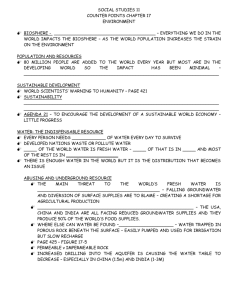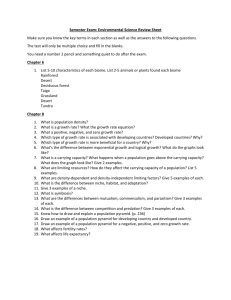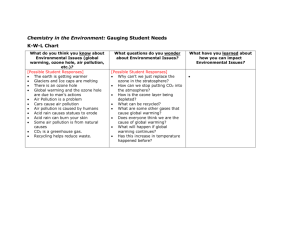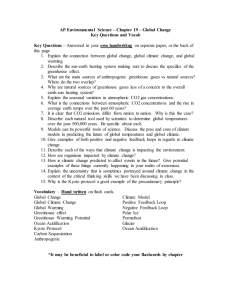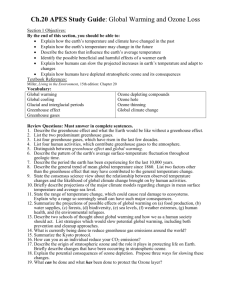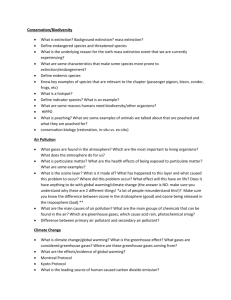Key Terms
advertisement
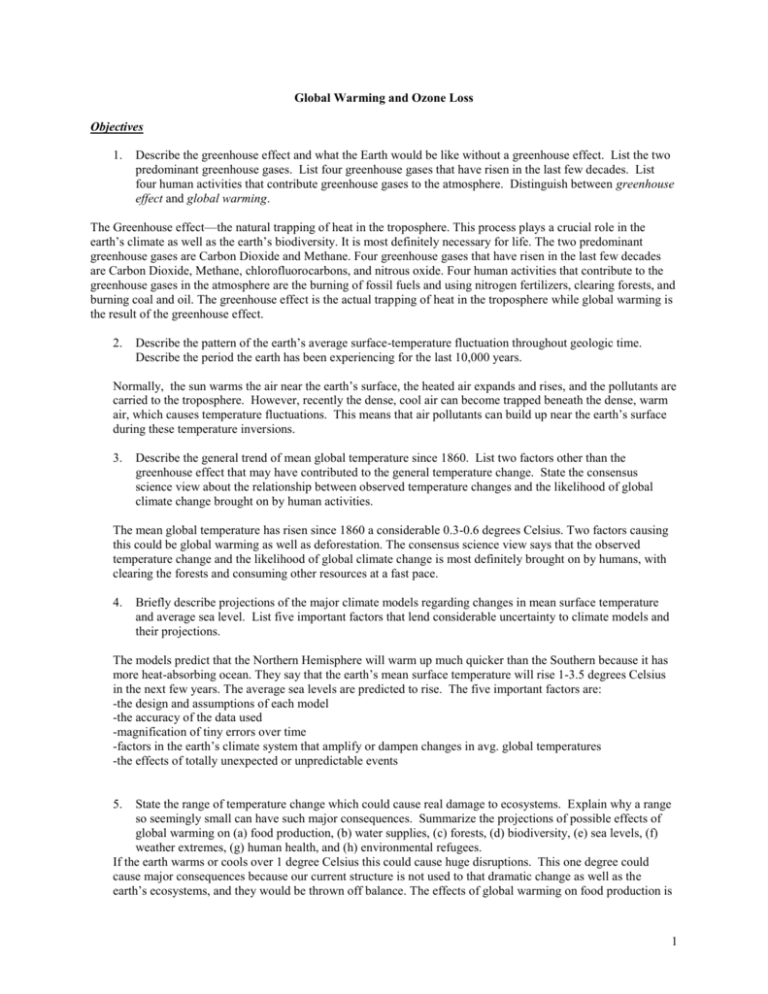
Global Warming and Ozone Loss Objectives 1. Describe the greenhouse effect and what the Earth would be like without a greenhouse effect. List the two predominant greenhouse gases. List four greenhouse gases that have risen in the last few decades. List four human activities that contribute greenhouse gases to the atmosphere. Distinguish between greenhouse effect and global warming. The Greenhouse effect—the natural trapping of heat in the troposphere. This process plays a crucial role in the earth’s climate as well as the earth’s biodiversity. It is most definitely necessary for life. The two predominant greenhouse gases are Carbon Dioxide and Methane. Four greenhouse gases that have risen in the last few decades are Carbon Dioxide, Methane, chlorofluorocarbons, and nitrous oxide. Four human activities that contribute to the greenhouse gases in the atmosphere are the burning of fossil fuels and using nitrogen fertilizers, clearing forests, and burning coal and oil. The greenhouse effect is the actual trapping of heat in the troposphere while global warming is the result of the greenhouse effect. 2. Describe the pattern of the earth’s average surface-temperature fluctuation throughout geologic time. Describe the period the earth has been experiencing for the last 10,000 years. Normally, the sun warms the air near the earth’s surface, the heated air expands and rises, and the pollutants are carried to the troposphere. However, recently the dense, cool air can become trapped beneath the dense, warm air, which causes temperature fluctuations. This means that air pollutants can build up near the earth’s surface during these temperature inversions. 3. Describe the general trend of mean global temperature since 1860. List two factors other than the greenhouse effect that may have contributed to the general temperature change. State the consensus science view about the relationship between observed temperature changes and the likelihood of global climate change brought on by human activities. The mean global temperature has risen since 1860 a considerable 0.3-0.6 degrees Celsius. Two factors causing this could be global warming as well as deforestation. The consensus science view says that the observed temperature change and the likelihood of global climate change is most definitely brought on by humans, with clearing the forests and consuming other resources at a fast pace. 4. Briefly describe projections of the major climate models regarding changes in mean surface temperature and average sea level. List five important factors that lend considerable uncertainty to climate models and their projections. The models predict that the Northern Hemisphere will warm up much quicker than the Southern because it has more heat-absorbing ocean. They say that the earth’s mean surface temperature will rise 1-3.5 degrees Celsius in the next few years. The average sea levels are predicted to rise. The five important factors are: -the design and assumptions of each model -the accuracy of the data used -magnification of tiny errors over time -factors in the earth’s climate system that amplify or dampen changes in avg. global temperatures -the effects of totally unexpected or unpredictable events 5. State the range of temperature change which could cause real damage to ecosystems. Explain why a range so seemingly small can have such major consequences. Summarize the projections of possible effects of global warming on (a) food production, (b) water supplies, (c) forests, (d) biodiversity, (e) sea levels, (f) weather extremes, (g) human health, and (h) environmental refugees. If the earth warms or cools over 1 degree Celsius this could cause huge disruptions. This one degree could cause major consequences because our current structure is not used to that dramatic change as well as the earth’s ecosystems, and they would be thrown off balance. The effects of global warming on food production is 1 that it would increase food production in some places and lower it in others. The rising sea levels also could flood the farms. Warmer water could damage fish. Biodiversity could be reduced, which would affect the food production negatively. Water supplies would be reduced—which would have a negative effect on populations. Forests and biodiversity would both shrink . Sea levels would rise, which would have negative effects on other resources, such as crops, with the flooding. Weather will become more intense, such as hurricanes and tornadoes, as well as the number of storms. Global warming would bring more heat waves—which would bring heat related deaths onto the scene. Also the number of environmental refugees would go up dramatically. 6. Describe three schools of thought about global warming and how we as a human society should act. List seven strategies which would slow potential global warming, including both prevention and cleanup approaches. The first school of thought on global warming is the idea that global warming is not a threat and that the people who are speaking of it are speaking a hoax. Another group of scientists believe that we should wait until we get more information to act on the global warming threat. A third group of scientists believe that we need to adopt a precautionary principle against global warming. The seven stratigies of slowing down or reducing global warming are using nuclear power, using natural gas, phasing out government subsidies for fossil fuels, agreeing to national limits on greenhouse gas emissions, and allowing industries and countries to sell and trade emissions permits in the marketplace, and reducing deforestation. 7. Describe the origin of stratospheric ozone and the role it plays in protecting life on Earth. Briefly describe changes which have been occurring in stratospheric ozone. Oxygen is converted to ozone in the stratosphere to form the ozone layer. It is renewable, and it protects humans against the harmful ultraviolet radiation. The ozone blocks out almost all of it. The ozone layer is vital to our survival on Earth. The ozone level is slowly dropping within the last 15 years. It has dropped 5-15% in the winter, and the Earth has lost a total of 4% of the ozone in 15 years. 8. Describe the scientific work on CFCs and their relationship to ozone. Describe the political response to the scientific information. Summarize the consensus science view of CFCs and stratospheric ozone. Summarize alternative views that have received much attention. Explain the significance of a critically thinking citizenry to the democratic process. CFCs are a chemical that was used for cleaners, sterilants, fumigants, and plastic used for packaging. CFCs, when released into the atmosphere breakdown the ozone layer. They last in the stratosphere for a very long time, therefore, stay harmful to the ozone layer. The countries, when hearing of this damage CFCs did, decided to start phasing them out. The companies that made them attacked, and finally CFCs were ultimately taken away, when the companies agreed that they were harmful to the ozone. 9. Explain the potential consequences of ozone depletion. Propose three ways for slowing these changes. If the ozone is depleted, then the chances of getting melanoma goes up, as well as cataracts—which leads to blindness. Skin cancer will go up, humans immune systems will be weakened, crops will be lost, forest productivity will go down. One way is to stop all ozone depleting chemicals, and then substituting CFCs, as well as using technofixes. Key Terms Greenhouse effect (p. 499)-heat-trapping gases in the troposphere Global warming (p. 501)- the phenomen that happens when the greenhouse effect increases Notes 19.1 The Greenhouse Effect and Global Warming What Do We Know About the Greenhouse Effect? greenhouse effect - certain gases in the atmosphere trap heat in the troposphere 2 amount of heat trapped in the troposphere depends mainly on concentrations of greenhouse gases and how long they stay in the atmosphere o major greenhouse gases 1. water vapor (H2O) 2. carbon dioxide (CO2) 3. ozone (O3) 4. methane (CH4) 5. nitrous oxide (N2O) 6. chlorofluorocarbons (CFCs) o 2 predominant greenhouse gases water vapor - fairly high concentration (1-5%) inputs from human activities have little effect on its greenhouse effects CO2 - small concentration (.036%) large input from human activities significantly affect greenhouse effects What is Global Warming? global warming - enhancement of the earth’s natural greenhouse effect due to rises in atmospheric levels of certain greenhouse gases o increased levels since 1958 mostly caused by human activities (burning fossil fuels, agric., deforestation, use of CFCs) developed countries account for 60% of CO2 emissions (US = 23%); developing countries for 40% preindustrial level - atmospheric concentration of CO2 at 280 ppm at start of the industrial revolution o 1860-1997 - concentration grew to 364 ppm What is the Scientific Consensus About the Earth’s Past Temperatures? Antarctic glaciers provide info about temp & contents of the atmos in the past o earth’s avg. surface temp has fluctuated significantly over geologic time glacial periods last 100,000 yrs -- followed by warmer interglacial period (10,000-12,500 yrs) o Holocene - latest interglacial period climatic stability prevented drastic changes in soils & vegetation patterns large increases in food production & population past 160,000 yrs - tropospheric H2O levels have remained fairly constant; CO2 levels fluctuated between 190 & 290 ppm o changes in CO2 correlate closely w/variations in earth’s mean surface temp o Intergovernmental Panel on Climate Change (IPCC) says global temp increases are unlikely result entirely from natural causes How Do Scientists Model Greenhouse Warming? Computer Models as Crystal Balls scientists use mathematical models that project the effects of increases in greenhouse gases on avg. global temp & changes in the earth’s climate o the most sophisticated of the climate models are general circulation models (GCMS) o models involved in making predictions about effects of human activities & natural processes 1. levels of greenhouse gases 2. avg. global temp 3. changes in regional climate 4. possible effects of changes in the diff areas What is the Scientific Consensus About Future Global Warming and Its Effects? IPCC projects earth’s mean surface temp should rise 1-3.5°C from 1990-2100 o lowest increase of 1°C -- earth would be warmer than it’s been for 10,000 yrs climate change, once begun, will continue for hundreds of years o northern hemisphere should warm more & faster than southern b/c latter has more heat-absorbing ocean than land & water cools more slowly than land o climate models project more pronounced warming at the poles o as earth’s atmos warms, rate of water evaporation will increase & global avg. precip will rise o other signs of global warming increased retreat of some glaciers on tops of mountains in the Alps, Andes, Himalayas, Northern Cascades northward migrations of warm-climate fish & trees 3 spread of tropical diseases away from equator bleaching of coral reefs in tropical areas w/warmer water o warmer climate rise in global sea levels -- 2/3 of rise caused by global warming melting of ice sheets & glaciers at poles will cause sea level to rise much more o warming/cooling by more than 1°C over a few decades causes major disruptions of earth’s ecosystems & human econ/social systems 19.2 Global Warming or a Lot of Hot Air? How Serious is the Threat? Will the Earth Really Get Warmer? much controversy over global warming, amount of temp increases & effects of increases o many past measurements & estimates are imprecise o only 100 yrs of accurate data -- hard to separate climate noise (short-term ups and downs of global temperatures) from overall rise in avg. global temp How Do Changes in Solar Output Affect Earth’s Temperatures? solar output varies by .1% over 11-yr & 22-yr sunspot cycles sunspots occur when strong solar magnetic fields periodically protrude thru the sun’s surface & increase the sun’s energy output can temporarily warm/cool the earth How Do the Oceans Affect Climate? oceans amplify global warming by releasing more CO2 into the atmos/dampen it by absorbing more heat o currently help moderate tropospheric temp by removing 29% of excess CO2 humans add to atmos o unknown if they can absorb more -- depends on how long the heat takes to reach deeper layers deep vertical mixing occurs very slowly as water density increases w/depth concern about disruption of deep ocean currents o currents transfer heat from one place to another & store CO2 in the sea Atlantic Ocean - heat transported north from tropical waters to Europe o global warming could reduce density & salinity of North Atlantic water water won’t sink stop thermal conveyer belt How Do Water Vapor Content and Clouds Affect Climate? changes in water vapor content & amount/types of cloud cover affect climate warmer temp increase evaporation & water-holding capacity of air more clouds o hard to predict effect of more clouds on climate 1. warming effect (pos. feedback) by trapping heat 2. cooling effect (neg. feedback) by reflecting sunlight back into space result of effects depends on if it’s day/night and on type & altitude of clouds - day - clouds are reflective cooling effect - night - insulating effect warmer temp - high & thin (cirrus) clouds warming effect - low & thick clouds cooling effect How Might Changes in Polar Ice Affect Climate? albedo - the ability of the earth’s surface (land, water, or ice) to reflect light o land & water - dark-colored surfaces absorb heat o polar ice caps & high, thin clouds reflect most light back into space Greenland & Antarctic ice sheets = high albedo = giant mirrors if warmer temp melted ice & exposed ground/ocean more sunlight absorbed global warming accelerated (pos. feedback loop) early stages of global warming could increase amount of water vapor drop more snow on glaciers ice sheet grows reflect more light help cool the atmos (neg. feedback loop) How Might Air Pollution Affect Climate? global warming might be offset partly by aerosols (tiny droplets and solid particles) of various air pollutants released/formed in atmos by volcanic eruptions & human activities suggest that SO2 & other particles could attract enough water molec to form clouds w/high albedo o 90% SO2 emissions occur in heavily industrialized northern hemisphere may undergo cooling offset/delay global warming similar effect could occur in s. hemi. from particles in smoke from large-scale burning of rain forests, grasslands, agric waste, and wood pollutants in lower troposphere can warm/cool the air depending on reflectivity of underlying surface 4 it is unlikely that air pollutants will counteract projected global warming aerosols = major components of acid deposition (acid rain) o slows forest growth & weakens/kills trees reduces trees’ ability to absorb CO2 accelerate global warming o although they might temporarily offset warming, it has serious harmful impacts on plant/animal life How Might Increased CO2 Levels Affect Photosynthesis and Methane Emissions? some studies suggest more CO2 will increase rate of photosynthesis remove more CO2 help slow global warming o others say the effect varies with types of plants & climate zones o additional growth from high CO2 concentrations may be concentrated in plant parts not consumed by people plant growth could be offset by faster breeding weeds/insects stomata - tiny pores in leaf surfaces that allow CO2 to enter for photosynthesis & let water out thru evapotranspiration o CO2 levels likely to worsen global warming stomata will stay closed longer hot water can’t escape plants get hotter & warm surroundings acid deposition of nitric acid/nitrate salts & use of nitrate fertilizers overload ecosystems w/nitrogen forest turnover - how fast trees grow and die in a forest o study shows turnover in tropical forests is accelerating reduce biodiversity of tree species enhance global warming (reduce CO2 removal as less dense, faster-growing trees need less CO2) increase in methane from wetlands global warming o more CO2 taken in by wetlands more methane released o warmer temp melt permafrost in tundra soils release methane How Rapidly Could Climate Shift? gradual moderate change over several 100 yrs -- people may adapt to new conditions change over decades -- may not be able to switch food-growing regions/relocate world pop fast enough o premature deaths (lack of food, social & econ chaos, reduction of biodiversity, etc.) small rises in greenhouse gas concentrations could trigger rapid shifts in avg. global temps How Could Human Responses Accelerate Global Warming? warmer earth people in urban areas use more air conditioning o burn more fossil fuels for more electricity more CO2 additional warming pos. feedback climate changes & its effects = erratic & mostly unpredictable 19.3 Some Possible Effects of a Warmer World Why Should We Worry If the Earth’s Temperature Rises a Few Degrees? temp rise refers to global change in climate (weather avg’d over decades, centuries, and millennia) -- not local weather How Might Food Production Be Affected? warmer global climate could increase/lower food production in diff areas o climate belts would shift north by 100-150 km/up 150 m in altitude for each 1°C rise o increased crop productivity in new crop-growing areas depends on… fertility of the soil availability of money to build new agric infrastructure (irrigation, food storage/distribution, etc.) o climate models project 10-70% declines in global yield of key crops & 10-50% loss in cropland area 10% drop in crop yields large increases in hunger & starvation winter kills insects & eggs -- temp determines how far from equator insects can live o temp rise exploding insect pop, crop diseases, weeds rising sea levels flood low-lying coastal areas where crops are grown o flood coastal wetlands, marshes, mangrove swamps decrease seafood supplies o water temp increase affect fish pop & decrease zooplankton destroy coral reefs reduce biodiversity How Might Water Supplies Be Affected? lakes, streams, and aquifers could shrink/dry up forced migration to new water supplies What Effects Might Global Warming Have on Forests and Biodiversity? global warming will change makeup & location of forests 5 o o trees & plants move as seeds to more favorable conditions but tree species move slowly thru growth of new trees (0.9 km/yr or 9 km/decade) some species won’t migrate fast enough & will die out forest diebacks release carbon stored in biomass & soil global warming climate change reductions in biodiversity o mass extinction of plant/animal species that can’t migrate to new areas What Could Happen to Sea Levels? heated water expands/land-based glacial ice melts rising sea levels 1990-2100 - levels projected to rise 15-95 cm o many cities built close to/below sea level defenses (levees, dikes, etc.) would be overwhelmed o 1/3 of world’s people & econ infrastructure in coastal regions -- flooding o flooding coastal estuaries, wetlands, coral reefs -- fisheries at risk o move barrier islands farther inland, accelerate coastal erosion, contaminate coastal aquifers w/salt water, flood tanks storing hazardous chemicals in coastal areas How Might Weather Extremes Change? more heat retained in climate system more air will move across earth’s surface o higher wind speeds, more clashing warm/cold fronts, more violent weather conditions o increased intensity of hurricanes, typhoons, tornadoes, and violent storms major increase in weather extremes could bankrupt insurance/banking industries - many companies are raising premiums for covering damages/dropping coverage - 1995 Nov - 40 insurance companies signed a declaration committing themselves to reducing the threat of global climate change -- urging gov leaders to get serious about global warming How Might Human Health Be Affected by Global Warming? global warming more heat waves o double/triple heat-related deaths among elderly & ppl w/heart disease o increase suffering from respiratory ailments (asthma, bronchitis, etc.) warming would disrupt supplies of food & fresh water displace millions & alter disease patterns o spread of warmer, wetter tropical climates malaria, encephalitis, yellow fever, dengue fever, etc. higher ocean temp algal blooms cholera epidemics higher humidity levels fungal skin diseases, yeast diseases, prickly heat & heat rash atmospheric warming increase air pollution in winter & exposure to dusts, pollens, and smog in summer warmer, more humid conditions speed growth of bacteria & molds on foods climate change is a major threat to global enviro security -- could increase enviro refugees 19.4 Solutions: Dealing with the Threat of Global Warming Should We Do More Research or Act Now? 3 schools of thought concerning global warming 1. no-problem view - very small group of scientists global warming is not a threat -- hoax clouded the issue, cooled public support for action, slowed international negotiations 2. waiting strategy - humans should wait until there is more info about the global climate system, global warming & its effects before taking action 3. precautionary strategy - take informed preventive action before there is info to justify action to deal with global warming believe increased spending on research won’t provide solid answers for a complex problem 1997 meeting of American Economics Association - believed preventive steps are justified those who favor doing nothing believe humans are overestimating impact of greenhouse gases boiled frog syndrome - trying to alert a frog to danger as it sits in a pan of water being heated on a stove -- does not believe it will die dies b/c it has no evolutionary experience of lethal effects of boiling water o humans don’t understand impending danger from global warming no-regrets strategy - taking actions needed to slow global warming even if there is no threat b/c of enviro, health, and econ benefits How Can We Slow Possible Global Warming? stabilizing CO2 levels would require reducing emissions by 66-83% (highly unlikely) o 1990-2010 - emissions projected to increase 50% 6 o most effective way to reduce emissions over next 2-3 decades is to use energy more efficiently increase use of nuclear power -- 1/6 as much CO2 per unit electricity as coal using natural gas could help make transition to age of energy efficiency/renewable energy o burned - emits ½ as much CO2 per unit of energy as coal o but reliance on natural gas can increase methane inputs global warming phase out gov subsidies for fossil fuels & phase in carbon taxes on fossil fuels based on emissions of CO2 & other air pollutants o 1997 - 2,500+ economist signed a statement 1. stating sound econ analysis shows greenhouse emissions can be cut w/o harming American living standards 2. calling for carbon taxes as part of international system of tradable permits for greenhouse gas emissions o revenues ideally used to improve energy efficiency & heating for poor in developed/developing countries provide them w/enough energy to offset higher fuel prices subsidize transition to improved energy efficiency & renewable energy o based on polluter-pays principle - industries/consumers directly pay full enviro costs for fuels they use agree to global & national limits on greenhouse emissions & allow industries/countries to sell & trade emission permits reduce deforestation & switch to more sustainable agric slow pop growth remove CO2 from exhaust gases of fossil fuel-burning vehicles, furnaces, & industrial boilers massive global reforestation program o best potential for increasing uptake of CO2 in tropical forests (80%); temperate (17%) & boreal (7%) o fairly inexpensive way to temporarily slow CO2 buildup Can Technofixes Save Us? technofixes - technological solutions for dealing with possible global warming o add iron to oceans to stimulate growth of marine algae remove more CO2 thru photosynthesis o unfurl large foil-surface sun mirrors in space to reduce solar input o inject sunlight-reflecting sulfate particulates into stratosphere to mimic cooling effect of volcanic eruptions costly & might not work -- more effective & cheaper to improve energy efficiency & shift to renewable energy What Has Been Done to Reduce Greenhouse Gas Emissions? 1992 Earth Summit (Rio de Janeiro) - 106 nations approved Convention on Climate Change o developed nations commit themselves to reduce their greenhouse emissions to 1990 levels by 2000 did not require nations to reach the goal -- most won’t 1997 Dec - Kyoto treaty a. requires 38 developed countries to cut greenhouse emissions to avg. of 5.2% below 1990 levels between 2008-2012 b. requires European industrialized nations to lower greenhouse emission to 8% below 1990 levels, US 7% below, Japan 6% below between 2008-2012 c. doesn’t require developing countries to make emission cuts d. allows emissions trading - country that beats its goal can sell excess reductions to failed countries e. allows forested countries to get a break in quota b/c trees absorb CO2 f. allow penalties for countries that violate the treaty o strong opposition in US Senate for ratifying the treaty b/c developing countries are excluded 1998 - Costa Rica launched world’s first greenhouse gas trading project o raise funds to buy & protect 5,000+ km² rainforest by selling companies allowances to emit CO2 into atmos o some fear industrialized countries will buy their way out of meeting their goals would take at least 60% reduction in emissions to slow warming to an acceptable level o many doubt countries will even be able to meet their goals How Can We Prepare for Possible Global Warming? most solutions won’t be done/will be done too slowly 19.5 Ozone Depletion: Is it a Serious Threat? What is the Threat from Ozone Depletion? ozone layer - stratospheric global sunscreen produced by evolution of photosynthetic oxygen-producing bacteria 7 o oxygen continuously converted to ozone & back in the stratosphere 3O2 + UV 2O3 o absorbs 99% of harmful incoming UV radiation from sun o avg. levels of ozone don’t change much b/c rate of ozone destruction = rate of formation UV radiation reading stratosphere consists of 3 bands 1. UV-C radiation - highest energy, shortest wavelength; nearly all is blocked out by ozone layer 2. UV-B radiation - next highest-energy & biologically damaging; ½ is blocked 3. UV-A radiation - lowest-energy; only small part blocked ozone depletion by certain chlorine- and bromine-containing chemicals released into atmos by human activities pose a serious long-term threat to plant/animal life 1979-94 - earth lost avg. of 4% ozone avg. ozone levels projected to drop 7-13% during 1990s What Causes Ozone Depletion? From Dream Chemicals to Nightmare Chemicals Freons - trade name for chlorofluorocarbons (CFCs); most widely used are CFC-11 (trichlorofluoromethane) & CFC-12 (dichlorofluoromethane) o stable, odorless, nonflammable, nontoxic, noncorrosive dream chemicals o cheap to make popularly used as coolants in air conditioners & refrigerators sterilants for hospital instruments propellants in aerosol spray cans fumigants for granaries & ship cargo holds cleaners for electronic parts bubbles in plastic foam used for insulation & packaging o 1974 - chemists Sherwood Rowland & Mario Molina indicated CFCs were lowering avg. concentration of stratospheric ozone molec are insoluble in water & chemically unreactive, not removed from the troposphere - rise slowly from the troposphere into the stratosphere molec breaks down & exposed to UV rays release reactive chlorine atoms speed up breakdown of ozone ozone destroyed faster than it’s formed - CFC molec can last in stratosphere for 65-110 yrs took 15 yrs since 1974 before countries agreed to phase out CFCs o 1988 - Du Pont Co. (leading company of CFC industry) acknowledged harmful effects of CFCs What Other Chemicals Deplete Stratospheric Ozone? ODCs - all ozone-depleting compounds 1. bromine-containing compounds group halons & HBFCs (used in fire extinguishers) methyl bromide (CH3Br) used as a fumigant 2. chlorine-containing compounds group carbon tetrachloride (CCl4) - cheap, highly toxic solvent methyl chloroform - 1,1,1-trichloroethane (C2H3Cl3) - used as cleaning solvent for clothes & metals and as a propellant in 160+ consumer products 3. emission of hydrogen chloride (HCl) by US space shuttle vehicles Why is There Seasonal Thinning of Ozone Over the Poles? ozone thinning - destruction of 40-50% of stratospheric ozone over Antarctica during spring and early summer o continues to expand in most years avg. seasonal ozone levels over Antarctica have been dropping since 1974 & are getting worse o 1987 - research plane flew into stratosphere & measured chlorine & ozone concentrations link between ozone depletion & CFCs established polar vortex - huge swirling mass of very cold air that is isolated from the rest of the atmos until the sun returns; produced in the winter as steady winds blow in circular pattern over the poles o tiny ice crystals formed as water droplets from clouds enter crystals collect CFCs & other ODCs speed up chem. reactions that release Cl atoms & ClO - ClO atoms combine w/each other Cl2O2 molec can’t react w/ ozone accumulate in vortex - Antarctic spring - light breaks up stored Cl2O2 molec release large number of Cl atoms ozone thinning vortex breaks up ozone-depleted air flow north & linger over Australia, New Zealand, South America, & South Africa 8 similar ozone thinning occurs in north pole ozone-depleted air lingers over Europe, North America, & Asia ozone loss is lower than south pole global warming changes wind patterns Arctic becomes more isolated & stays colder increase size & duration of seasonal ozone-depleting vortexes over both poles Why Should We Be Worried About Ozone Depletion? Life in the Ultraviolet Zone less ozone more UV-B radiation worse sunburns, more cataracts, more skin cancers Australia has the world’s highest rate of skin cancer o broadcast daily UV levels effects of increased UV exposure o suppression of immune system o increase in acid deposition & ozone in smog in troposphere o lower yields of key crops (corn, rice, cotton, soybeans, etc.) o decline in forest productivity -- many trees sensitive to UV-B global warming o increased breakdown & degradation of materials (paints, plastics, out door materials) o reduction in productivity of phytoplankton upset aquatic food web decrease seafood yields o damage to ecological structure & function of lakes b/c of deeper penetration of UV light worst-case scenario - people would have to completely avoid the sun o cattle can only graze at dusk, outdoor workers limit exposure to sun to minutes plants & other animals can’t adapt as quickly to UV-B increases as humans 19.6 Solutions: Protecting the Ozone Layer How Can We Protect the Ozone Layer? must immediately stop producing all ODCs o even w/immediate action, it will take 50-60 yrs for ozone layer to return to 1975 levels use substitutes for CFCs o hydrochlorofluorocarbons (HCFCs) - shorter lifetimes in stratosphere (i.e. CHClF2 - fewer chlorine atoms) large quantities would still cause ozone depletion HCFC-123 may be causing acute hepatitis & other liver abnormalities o hydrofluorocarbons (HFCs) - negligible effect on ozone depletion (i.e. CF3 - no chlorine/bromine) powerful greenhouse gases that stay in atmos longer than CFCs or CO2 - may need to be restricted/phased out hydrocarbons (HCs) such as propane & butane are a better way to reduce ozone depletion while doing little to enhance global warming o useful as coolants & insulating foam in refrigerators o cannot be patented/can be manufactured locally good for developing countries Can Technofixes Save Us? Alfred Wong proposed launching a fleet of blimps into stratosphere above Antarctica each year o curtain of electrical wires hanging from blimps would inject negatively changed elects into stratosphere chlorine atoms pick up electron chloride ions can’t react w/ ozone o send in 2nd sheet of pos. charged wires to remove ions from stratosphere o Ciecerone says it won’t work b/c other chemicals pick up electrons faster than chlorine unpredictable side effects on atmospheric chemistry use thousands of lasers to blast CFCs out of atmos before reaching the stratosphere What is Being Done to Reduce Ozone Depletion? 1987 - 36 nations met in Montreal o developed a treaty, Montreal Protocol, to cut emissions of CFCs by 35% between 1989 & 2000 met in London (1990), Copenhagen (1992), Montreal (1997) - adopted protocol accelerating phaseout of key ODCs agreements reached so far led to… o 85% drop in CFC production from 1988-1998 o sharp drop in production of halons, carbon tetrachloride, & methyl chloroform Will the International Treaty to Slow Ozone Depletion Work? concern that requirements of Copenhagen agreement won’t be met o 1995 - political & econ backlash in US against the treaty treaty effectiveness undermined by growing black market in CFCs - 9 some countries aren’t living up to requirements of ozone treaty treaty set important precedent for global cooperation & action o international cooperation in dealing w/global warming = more difficult evidence is less clear-cut lowering greenhouse emissions = economically & politically difficult Key Terms greenhouse effect (499) - the process in which certain gases in the atmosphere trap heat in the troposphere global warming (501) - enhancement of the earth’s natural greenhouse effect due to rises in atmospheric levels of certain greenhouse gases preindustrial level (501) - atmospheric concentration of CO2 at 280 ppm at the start of the industrial revolution general circulation models (GCMS) (503) - climate models used to project the effects of increases in greenhouse gases on average global temperature and changes in the earth’s climate climate noise (505) - short-term ups and downs of global temperatures albedo (506) - the ability of the earth’s surface (land, water, or ice) to reflect light aerosols (507) - tiny droplets and solid particles acid rain (507) - acid deposition forest turnover (508) - how fast trees grow and die in a forest climate (508) - weather averaged over decades, centuries, and millennia no-problem view (514) - the view that global warming is not a threat; some claim it is a hoax waiting strategy (514) - humans should wait until there is more information about the global climate system, global warming, its effects before taking action precautionary strategy (514) - humans should take informed preventive action before there is information to justify action to deal with global warming boiled frog syndrome (514) - trying to alert a frog to danger as it sits in a pan of water slowly being heated on a stove -- does not believe it will die dies because it has no evolutionary experience of the lethal effects of boiling water no-regrets strategy (515) - taking actions needed to slow global warming even if there is no threat because of environmental, health, and economic benefits carbon taxes (516) - taxes on fossil fuels based on emissions of CO2 & other air pollutants polluter-pays principle (516) - industries and consumers directly pay full environmental costs for fuels they use technofixes (516) - technological solutions for dealing with possible global warming ozone layer (518) - stratospheric global sunscreen produced by evolution of photosynthetic oxygen-producing bacteria Freons (520) - trade name for chlorofluorocarbons (CFCs); most widely used are CFC-11 (trichlorofluoromethane) & CFC-12 (dichlorofluoromethane) ozone thinning (521) - destruction of 40-50% of stratospheric ozone over Antarctica during spring and early summer polar vortex (522) - huge swirling mass of very cold air that is isolated from the rest of the atmosphere until the sun returns; produced in the winter as steady winds blow in a circular pattern over the poles Montreal Protocol (528) - treaty developed to cut emissions of CFCs by 35% between 1989 & 2000 10 Practice Questions MULTIPLE CHOICE 1. The major greenhouse gases include all of the following except a. sulfur dioxide. b. ozone and nitrous oxide. c. chlorofluorocarbons (CFCs). d. carbon dioxide and water vapor. 2. The two predominant greenhouse gases in the troposphere are a. carbon dioxide and ozone. b. nitrous oxide and sulfur dioxide. c. carbon dioxide and water vapor. d. nitrogen and water vapor. 3. All of the following greenhouse gases have increased in recent decades except a. nitrous oxide. b. methane. c. carbon dioxide. d. water vapor. 4. Estimated variations in Earth's mean surface temperature over the past 135 years correlate closely with a. carbon dioxide b. CFCs. c. water vapor. d. ozone. 5. The greatest uncertainty in current climate models comes from a. measurements of wind speed and direction. b. effects of clouds and ecosphere on climate. c. patterns of variation in solar radiation. d. measurements of temperature and air pressure. 6. About 29% of the carbon dioxide released into the atmosphere by human activities a. is absorbed by the oceans. b. remains in the atmosphere. c. is absorbed by the soil. d. is absorbed by the growth of plants. 7. Evidence indicates that climate belts would shift toward the poles __________ miles for every 1°C increase. a. 90-120 b. 60-90 c. 10-30 d. 30-60 8. Tree species typically move __________ mile(s) per decade. a. 5 b. 1 c. 20 d. 10 9. A warmer world is least likely to result in a. a rise in sea level. b. reductions in biodiversity. 11 c. d. decreased food production. more moderate weather. 10. In a warmer world, we would expect more a. all of the above. b. hurricanes. c. droughts. d. prolonged heat waves. 11. A more scientifically accurate term for the “greenhouse effect”: a. tropospheric heating effect b. carbon dioxide trapping c. mesospheric warming d. amplified temperature growth cycle 12. The ability of a surface to reflect light: a. reflection b. refraction c. ample d. albedo 13. Children who use a sunscreen with a protection factor of 15 every time they are in the sun from age 1 to age 18 decrease their chance of getting skin cancer by how much?: a. 25% b. 55% c. 70% d. 80% 14. As part of the global carbon cycle, the ocean naturally removes 29% of what greenhouse gas? a. methane b. CFCs c. carbon dioxide d. carbon monoxide 15. Climate: a. local weather swings b. weather averaged over decades, centuries, and millennia c. predicted average daily temperature d. compiled weather reports 16. Compared to coal, natural gas emits __________ CO2 per unit of energy, and it emits far __________ amounts of most other air pollutants. a. 10x more, greater b. twice as much, greater c. twice as much, smaller d. only half as much, smaller 17. Each chlorine atom released from a CFC molecule can convert up to __________ molecules of O3 to O2. a. 10 b. 100 c. 1,000 d. 10,000 18. What is the most effective method to reduce atmospheric carbon dioxide buildup? 12 a. b. c. d. shift to natural gas increase energy use efficiency plant trees over an area equivalent to the size of Australia use more techno-fixes 19. Which of the following greenhouse gases lasts in the troposphere the longest? a. CO2 b. CH4 c. N2O d. CFCs 20. For the past 160,000 years, tests show that as the amount of CO2 increases, the temperature tends to... a. increase as well b. decreases c. remains about the same 21. The use of fossil fuels releases which of the following greenhouse gases? a. CO2 and N2O b. H2O and N2O c. CFC and CO2 d. CO2 and CH4 22. Which substances are the major substances involved in ozone depletion? I. O3 II. O2 III. CFC a. I b. II c. II and III d. I, II, and III 23. Which of the following contributes the most to the emissions of CFCs? a. fire extinguishers b. spray cans c. sterilants in hospitals d. leaking air conditioners 24. The following are ODCs except... a. HBFCs c. HCL b. d. C2H3Cl3 HBr FILL IN THE BLANK 1. A __________ niche will be the niche most affected by global warming. 2. Increasing the efficiency of energy use is the most effective way to reduce the buildup of __________ in the atmosphere. 3. Using energy more efficiently and halting deforestation address the threat of __________ warming. 4. Switching to __________ agriculture is a way to prevent global warming. 5. Sterilants in hospitals use __________. 6. __________ are the single greatest contributors to CFC emissions in the United States. 7. Human health problems such as eye cataracts and skin cancer are closely associated with ozone __________. 8. Methyl bromide, halons, and CFCs are examples of ozone depleting __________. 9. Changes in earth’s albedo, and changes in solar output affect changes in average __________. 10. Ozone depletion in the layer of earth known as __________ increases sunburns, cataracts, and skin cancers. 13 11. The __________ helped drop CFC production by 85% between 1988 and 1998. 12. Most climate models are derived from models developed for weather forecasting, called __________. 13. Most people do not realize that the protection factors for sunscreen are based on using __________ -- far more than most people apply. 14. Temperature increases tend to be greater at the earth’s __________ than at the mid-latitudes. 15. Tiny droplets and solid particles of various air pollutants released or formed in the atmosphere by volcanic eruptions and human activities are called __________. 16. Warmer temperatures increase evaporation of surface water and create more __________. 17. Warmer soil, especially at __________, will speed up plant decomposition and release more CO2. 18. For each 1°C rise in the earth’s average temperature, climate belts in mid-latitude regions would shift upward __________ meters in altitude. 19. Compared to crops grown with commercial fertilizer, crops grown with __________ fertilizer produce equivalent yields but much less CO2 through respiration. SHORT ANSWER 1. Rice paddies, guts of cattle and termites, landfills, coal production, coal seams, and natural gas leaks release what greenhouse gas? 2. Fossil fuel burning, deforestation, and plant burning release what greenhouse gas? 3. Air conditioners, refrigerators, and plastic foams release what greenhouse has? 4. What are certain atmospheric gases that warm the earth’s surface by absorbing infrared radiation called? 5. What percent of UV radiation from the sun is absorbed by O3 molecules in the earth’s stratosphere? 6. When humans release CFCs and ODCs into the air what gas decreases in concentration, resulting in more UV radiation reaching the earth’s surface? 7. If we act now to reduce the risks from climate changed, then we are adopting what kind of strategy? 8. What treaty gives countries or businesses that reduce their emissions of greenhouse gases, the chance to make money by selling their reductions to others? ESSAY QUESTION 1. How are climate change and ozone depletion related to each other? 2. Describe the greenhouse effect 3. How can we remove CO2 from the atmosphere? 14

